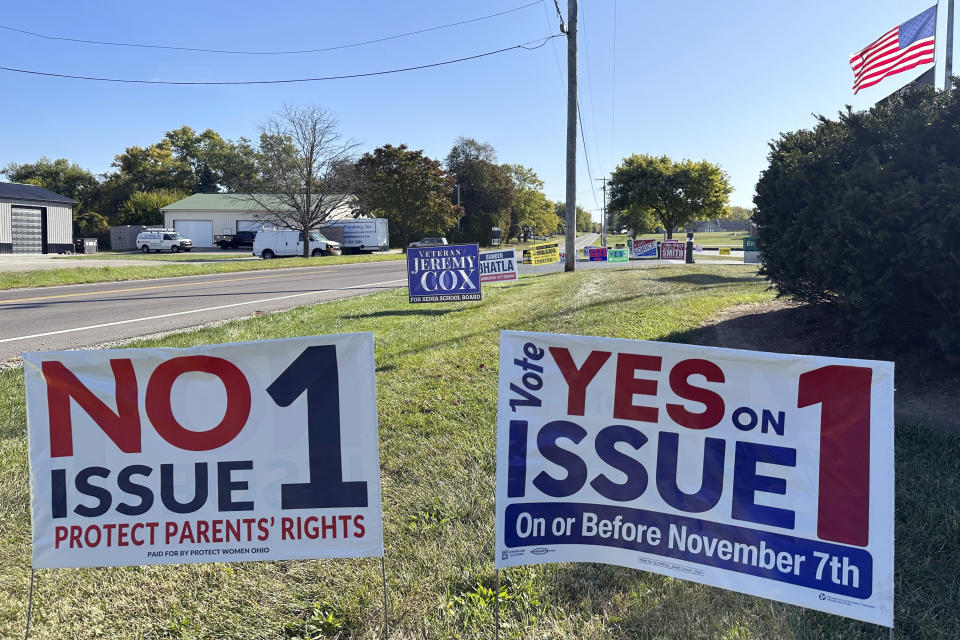Ohio is about to vote on abortion rights. Misinformation about the proposal is rampant
As Ohio residents prepare to conclude voting on a constitutional amendment that would guarantee access to abortion in the state, they're encountering an array of misleading claims over how it could influence abortion care, gender-related health care, parental consent and more.
The proposed amendment would give Ohio residents the right to make their own reproductive decisions. Supporters say that since the U..S. Supreme Court overturned Roe v. Wade last year, the proposal would restore a commonsense abortion protection most Ohio voters can support. AP VoteCast polling last year found that 59% of Ohio voters say abortion should generally be legal.
Opponents argue the amendment, referred to as Issue 1, would do far more than that. They are particularly concerned about the legal ramifications of the measure's health exception, its open-ended definition of reproductive healthcare, and how it protects the rights of “individuals,” rather than “women” or “adults.” Ads portray these aspects as gateways to children getting abortions and gender-related surgeries without their parents’ consent. Opponents also have falsely suggested the amendment would open doors to a federally banned abortion procedure.
The Associated Press spoke to numerous medical and legal experts, who explained what the amendment would mean if voters approve it:
AMENDMENT PRESERVES OHIO’S RIGHT TO RESTRICT ABORTIONS LATER IN PRE GNANCY
Anti-abortion advocates have claimed the measure would go further than Roe v. Wade, making it impossible for the Legislature to pass any abortion restrictions. But legal experts say that’s not true. The language of the amendment, which differs from that displayed in voting booths, uses almost verbatim language from the now-overturned Supreme Court decision that had granted a nationwide constitutional right to abortion.
If the amendment passes, Ohio lawmakers could still restrict abortion beyond the point when a fetus can survive outside the womb. With modern medicine, that point, referred to as the point of viability, is typically about 23 weeks or 24 weeks into pregnancy.
Yet opponents of the measure argue that the proposal would still allow for abortions “up to birth” because it lets doctors decide when a fetus is viable or not and because it has an exemption allowing later abortions to protect the life or the health of the mother.
“They could have made it clear. They could have added weeks in there for viability,” said Mehek Cooke, a lawyer working with the opposition campaign, Protect Women Ohio.
Independent medical and legal experts say this argument discounts that doctors have a duty to follow medical science.
The proposed amendment defines fetal viability as “the point in a pregnancy when, in the professional judgment of the pregnant patient’s treating physician, the fetus has a significant likelihood of survival outside the uterus with reasonable measures.”
“Obviously, it would be unprofessional for a doctor to say that a 9-month fetus had no possibility of survival outside the uterus unless there was some life-threatening birth defect,” said Dan Kobil, a constitutional law professor at Capital University Law School in Columbus, Ohio, who supports abortion rights. “The rationale offered that physicians have willy-nilly ability to define viability as anything they want is inaccurate.”
Abortions later in pregnancy are exceedingly rare. In 2020, less than 1% of abortions in the United States were performed at or after 21 weeks, according to the federal Centers for Disease Control and Prevention.
Abortions later in pregnancy also are usually the result of serious complications, such as fetal anomalies, that put the life of the woman or fetus at risk, medical experts say. In most cases, these are also wanted pregnancies, several experts said.
Experts say the idea of abortions “up to birth” is misleading in itself. Terminations later in pregnancy involve medication that induces birth early, which is different from a surgical abortion.
AMENDMENT’S FAILURE WOULDN’T IMMEDIATELY AFFECT CONTRACEPTION, MISCARRIAGE CARE
Supporters of the amendment have said it's necessary to guarantee access to contraception and emergency miscarriage care — a narrative opponents dispute.
If Issue 1 fails, access to contraception and emergency miscarriage care would not be immediately restricted. Current Ohio laws and policies safeguard those, Ohio Health Director Bruce Vanderhoff said in response to an inquiry by a Republican state lawmaker.
But proponents say proactive protections are still needed.
Access to contraceptives — especially emergency contraceptives such as Plan B — is often targeted in states with abortion restrictions, legal and medical experts say. Some states have attempted to limit Medicaid coverage for contraceptives. In other states, lawmakers have falsely conflated birth control and abortion, incorrectly referring to some forms of birth control as “ abortifacients ” that should be restricted.
When Roe was overturned, Supreme Court Justice Clarence Thomas said in a concurring opinion that the court should review other precedents, including a 1965 decision declaring that married couples have a right to use contraception.
Abortion restrictions also can have a chilling effect on care for miscarriages, examples from several states have shown. In states where abortion bans don’t clarify whether miscarriage care is criminalized, women have been denied care if there is detectable fetal cardiac activity or until there’s a medical emergency.
Nationally, attempts to restrict access to the abortion drug mifepristone also could affect miscarriage care.
THE AMENDMENT DOESN’T LEGALIZE WHAT OPPONENTS CALL “PARTIAL-BIRTH ABORTION”
The opposition campaign and top Republicans have referred to “partial-birth abortions” as an imminent threat if the measure passes. “Partial-birth abortion” is a non-medical term for a procedure known as dilation and extraction, or D&X, which is already federally prohibited.
The amendment would not override the existing federal ban if Ohio voters approve it.
An analysis of the amendment by the conservative Christian legal group Alliance Defending Freedom also claims the measure “opens the door to infanticide.” This is not true. Infanticide also is already illegal in the U.S., legal experts confirmed, and the amendment doesn’t change that.
“That’s just pure nonsense,” said David Cohen, a law professor at Drexel University.
The measure also would not legalize pedophilia or child sex trafficking, as conspiracy theories spread through ads have claimed.
THE AMENDMENT DOESN’T INVALIDATE PARENTAL CONSENT
The amendment does not change Ohio’s existing parental notification and consent law, which requires minors to have parental permission — or a judicial exception in extreme cases — to get an abortion.
“The Amendment does not specifically address parental consent," Republican Attorney General Dave Yost determined.
That has not stopped the measure’s opponents from arguing that it will be challenged in court, perhaps one day leading to a decision that would make the parental consent law unconstitutional.
Their argument is based on use of the term “individual” in the amendment, which opponents claim applies to any gender and both adults and children.
Similar arguments related to parental consent were made ahead of Michigan’s vote on abortion last year, but no such challenges have happened, said Jessie Hill, a law professor at Case Western Reserve University School of Law who serves as a consultant to the Issue 1 campaign.
To be overturned, Ohio’s existing parental consent law would have to be challenged in court and struck down by the state Supreme Court, whose conservative majority would likely vote to protect it.
CLAIMS THAT THE AMENDMENT IS ABOUT GENDER-RELATED HEALTH CARE ARE A STRETCH
Opponents of the abortion amendment say its protection of “reproductive” decisions is unnecessarily broad and could include gender-related health care.
Supporters say the proposal makes no mention of gender-related health care — precisely because it’s not about that.
The amendment specifies that it protects reproductive decisions “including but not limited to” contraception, fertility treatment, continuing one’s own pregnancy, miscarriage care and abortion.
Independent legal experts say it’s a stretch to suggest that also means gender-related health care. That legal theory has not been attempted in other states.
___
Associated Press writer Julie Carr Smyth in Columbus, Ohio, contributed to this report.
___
The Associated Press receives support from several private foundations to enhance its explanatory coverage of elections and democracy. See more about AP’s democracy initiative here. The AP is solely responsible for all content.

 Yahoo News
Yahoo News 

